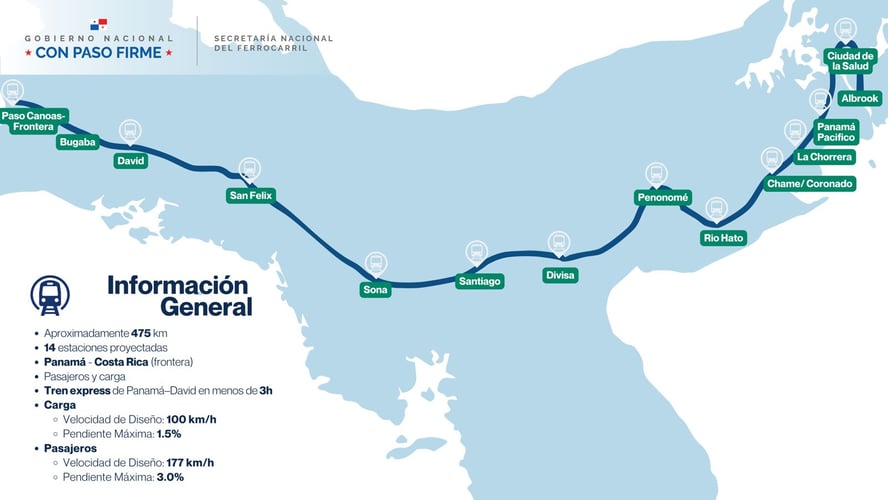Panama-David Railway Announced: Route, Stations, and Economic Impact
In a landmark announcement, President José Raúl Mulino officially presented the route and station locations for the highly anticipated Panama-David railway—an infrastructure project set to redefine mobility, logistics, and economic development across the country.
From Panama City to David in Three Hours
Spanning 475 kilometers from Panama Pacífico to the border town of Paso Canoas, the railway will connect Panama City to David in just three hours. Designed to meet international standards, the train system will feature:
-
Passenger trains with speeds of up to 180 km/h
-
Freight trains reaching up to 100 km/h
The route includes 14 key stations strategically located to maximize accessibility, economic impact, and interconnectivity:
-
Ciudad de la Salud
-
Albrook
-
Panama Pacífico
-
La Chorrera
-
Chame / Coronado
-
Río Hato
-
Penonomé
-
Divisa
-
Santiago
-
Soná
-
San Félix
-
David
-
Bugaba
-
Paso Canoas – Border
More Than a Train: A Platform for Inclusive Growth
“This train represents the unstoppable progress of Panama. It’s a living symbol of our nation's driving force—a hard-working people pushing us forward,” President Mulino said. He emphasized that over 50,000 Panamanians will be employed during the construction phase.
Beyond job creation, the project is designed to be a catalyst for long-term economic growth, particularly in regions beyond the capital. Each station has been chosen based on population density, urban development potential, existing infrastructure (like metro lines, ports, and airports), and regional economic strengths such as agriculture, tourism, and logistics.
Phased Development and Environmental Vision
The first phase of the railway—between Panama Pacífico and Divisa—is expected to begin earthworks in 2026, following the completion of technical studies and regulatory approvals. The project also emphasizes environmental responsibility, aiming to minimize ecological impact and promote cleaner, more efficient transportation.
Henry Faarup, head of the National Railway Secretariat, noted: “This isn’t just a mobility project—it’s a national investment platform. It will lower logistics costs, improve travel times, and stimulate new value chains throughout the country.”
The announcement also featured technical contributions from global firm AECOM and a visual journey of the railway created by Mallol Arquitectos, evoking both Panama’s historic railway legacy and its bold vision for the future.
At Reside Panama, we will continue to follow and report on the progress of this transformative project, which promises to reshape how we live, invest, and connect throughout the country.
.png?width=600&height=240&name=Untitled%20design%20(23).png)



